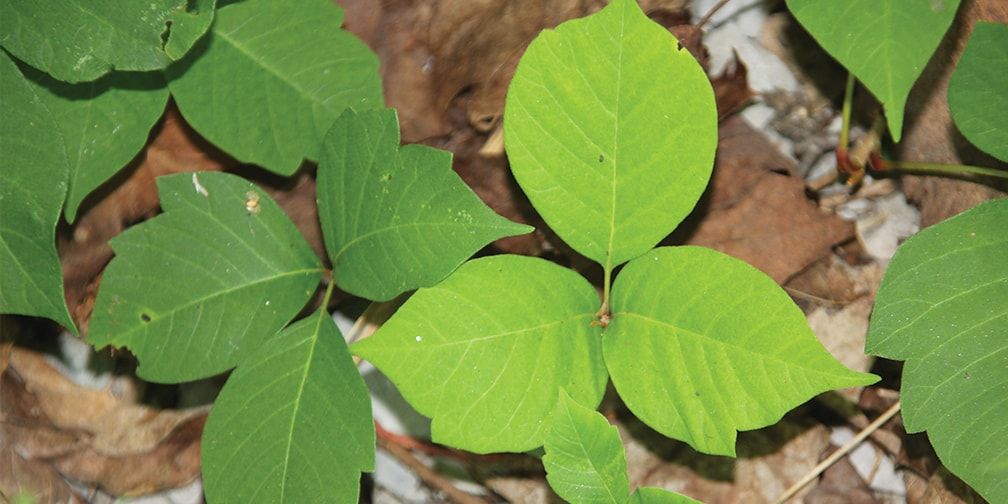Ontario Nature Blog
Receive email alerts about breaking conservation
and environmental news.
© Lora Denis
© Colleen Cirillo
Gardeners beware! Poison ivy was listed among the top 8 most toxic plants in Canadian gardens by The Weather Network. Scientifically known as the Rhus radicans L, this toxic climbing plant is abundant in South Ontario spreading all the way to Kenora and North Cochrane. It has also been found carpeting South of Lake Huron all the way to the Northern Bay.
Poison ivy is a very resilient plant that grows in both wet and dry areas. You can find it in swamps and deep woods, as well as dry sandy areas like along riversides. It can also be spotted by the road side, along fence rows and even in rock crevices. Poison ivy is sometimes compared to poison oak and poison sumac. However, the difference between the three is that poison ivy’s leaves are usually clustered in groups of three, and are a brighter green. The plant also features hairy vines.

The Poison ivy plant produces an oil resin called urushiol. Urushiol produces rashes when it comes into contact with the human skin. Contact typically occurs in 3 ways:

It does not take much urushiol to cause a reaction. Less than the size of a salt grain of urushiol is enough to cause a reaction in most people. Some of the most common symptoms include: redness of the skin, itching and swelling that can lead to the development of small or large blisters. Difficulty in breathing can also be experienced when you come into contact with smoke from burnt poison ivy.
These symptoms usually occur between 12 to 72 hours after contact with the plant. The severity depends on the amount of urushiol one has come in contact with and the individual resistance to allergic reactions are a determinant to how severe the rashes will be. Luckily, the rashes usually disappear after one to three weeks.

While there are over the counter drugs that can be used to remedy the symptoms mentioned above, there are plenty of poison ivy home remedies. These include washing the skin with warm water, calamine lotion or witch hazel. You can also apply fresh aloe vera on the affected areas. This should be done between 20 to 30 minutes after exposure to gain the best results.
Treatment can also be provided by a primary care physician. Only see a dermatologist when the conditions become severe, such as when puss starts to form. Though treatable, the best treatment for poison ivy is prevention. When contact is inevitable, wear protective clothing such as gloves and boots. Wash pet fur, tools or clothes 30 minutes after exposure to avoid coming into contact with urushiol.
Poison ivy does not have fatal consequences. Nevertheless, make sure that you know what poison ivy looks like and dress appropriately to avoid exposure.
Ali Anderson is a freelance writer who worked for several years in the health sector. She is married with two daughters and loves the flexibility of the freelance lifestyle.
Gananoque Lake Nature Reserve © Smera Sukumar
I would get poison at least twice a year when I was younger the best way too get rid of it is urine . The first sign of it i would dab a paper towel in my urine then put it on the blister it would be gone the next day . I tried every home remedy you can think of this one works
I am extremely sensitive to poison ivy.
What I have discovered is that dish detergent (Sunlight, Palmolive) will break up the oil and get rid of it. Shower using the dish detergent instead of soap ( soap spreads the oil with breaking it up.) and do this for a few days. Wash all your clothes in dish detergent. Dish detergent is excellent at breaking up oils – soap and laundry detergent do not. Keep this up and you will get rid of the poison ivy oil.
Calamine lotion and witch hazel may be better than nothing. But look at your poison ivy rash after the calamine lotion has dried and you will see new outbreaks of oil blisters. Wash with dish detergent! Good luck.
Hello!
I just went swimming at a small rocky river in Quebec, and there was poison ivy growing in some places on the banks. I have been exposed to urushiol oil 7 times before, and I am very sensitive to it.
I know urushiol oil can stay active for years on clothes and other things that have come into direct contact with it.
My question is: is it possible for the urushiol oil to spread to the rocks, moss, and tree roots nearby, by way of insects walking on the plants’ surface, then walking on the ground… or from people getting urushiol oil on their shoes, and spreading it around the ground… and if so, then is it possible for me to get the oil on my bare skin from sitting on the ground 10 feet from a plant (even if there are no poison ivy roots directly touching me)?
Its a complicated question, but I am very curious.
Basically, can the urushiol oil get transferred to a secondary surface, and that transfer it to a third surface, and then can I get a reaction if there is some oil on that third surface? And does this happen outside in the forest?
Also, is it possible for the urushiol oil to get into the river water?
I have had traumatizing experiences with rashes and household contamination from urushiol oil, so I am very concerned.
Thank you!
Tasha
If I get the oil on my clothes, how long is the oil active?
Hi Robyn,
That is a good question.
Poison ivy urushiol can stay active for many months and in other cases longer than a year.
ON Noah